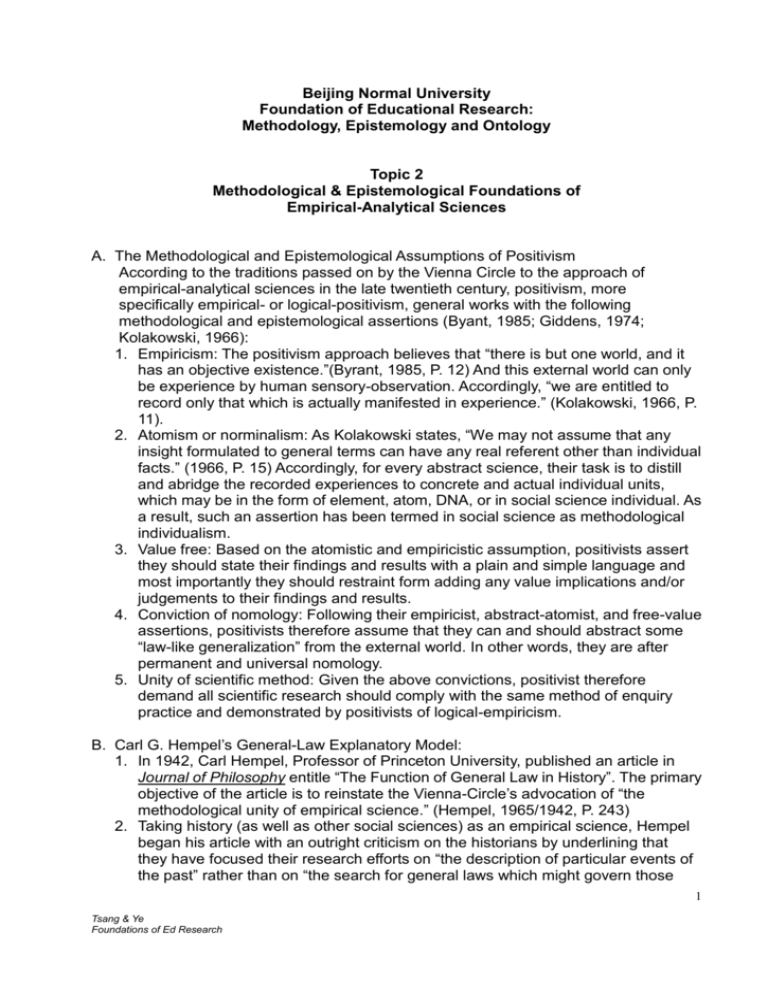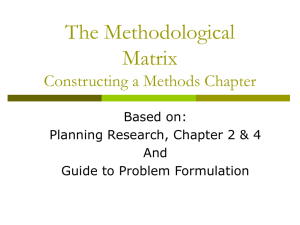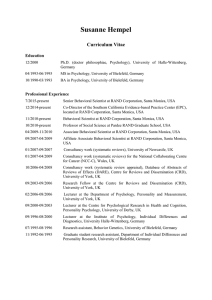Empirical Analytical Science
advertisement

Beijing Normal University Foundation of Educational Research: Methodology, Epistemology and Ontology Topic 2 Methodological & Epistemological Foundations of Empirical-Analytical Sciences A. The Methodological and Epistemological Assumptions of Positivism According to the traditions passed on by the Vienna Circle to the approach of empirical-analytical sciences in the late twentieth century, positivism, more specifically empirical- or logical-positivism, general works with the following methodological and epistemological assertions (Byant, 1985; Giddens, 1974; Kolakowski, 1966): 1. Empiricism: The positivism approach believes that “there is but one world, and it has an objective existence.”(Byrant, 1985, P. 12) And this external world can only be experience by human sensory-observation. Accordingly, “we are entitled to record only that which is actually manifested in experience.” (Kolakowski, 1966, P. 11). 2. Atomism or norminalism: As Kolakowski states, “We may not assume that any insight formulated to general terms can have any real referent other than individual facts.” (1966, P. 15) Accordingly, for every abstract science, their task is to distill and abridge the recorded experiences to concrete and actual individual units, which may be in the form of element, atom, DNA, or in social science individual. As a result, such an assertion has been termed in social science as methodological individualism. 3. Value free: Based on the atomistic and empiricistic assumption, positivists assert they should state their findings and results with a plain and simple language and most importantly they should restraint form adding any value implications and/or judgements to their findings and results. 4. Conviction of nomology: Following their empiricist, abstract-atomist, and free-value assertions, positivists therefore assume that they can and should abstract some “law-like generalization” from the external world. In other words, they are after permanent and universal nomology. 5. Unity of scientific method: Given the above convictions, positivist therefore demand all scientific research should comply with the same method of enquiry practice and demonstrated by positivists of logical-empiricism. B. Carl G. Hempel’s General-Law Explanatory Model: 1. In 1942, Carl Hempel, Professor of Princeton University, published an article in Journal of Philosophy entitle “The Function of General Law in History”. The primary objective of the article is to reinstate the Vienna-Circle’s advocation of “the methodological unity of empirical science.” (Hempel, 1965/1942, P. 243) 2. Taking history (as well as other social sciences) as an empirical science, Hempel began his article with an outright criticism on the historians by underlining that they have focused their research efforts on “the description of particular events of the past” rather than on “the search for general laws which might govern those 1 1 Tsang & Ye Foundations of Ed Research events” and “it is certainly unacceptable”. (Hempel, 1965, P. 231) Hempel then explicate in details his explanatory model by general law. 3. Deductive-nomological model: The ideal-typical model of explanation in empirical sciences (including both natural and social sciences) is what he characterizes as deductive-nomological model. The model is made up of three parts. a. The specific events (E) to be explained, in Hempel’s terms, the explanandum b. The possible antecedent condition (C) which brings about the occurrence of that specific events c. In order to logically induce a causal relation between E and C, a general law covering the occurrences of both E and C is needed. And by general law it means a statement of universal causal-conditions that has been empirically or logical confirmed. More specifically, causal conditions may be further differentiated into three types: i. Sufficient conditions: It refers to the kinds of conditionality between the C and E, in which the C can exhaustively but not universally explain the occurrence of E. ii. Necessary conditions: It refers to the kinds of conditionality between the E and C, in which the C can universally but not exhaustively explain the occurrence of E. iii. Sufficient and necessary conditions: It refers to the kinds of conditionality between the E and C, in which the C can both exhaustively and universally explain the occurrence of E. d. Taking together, the deductive-nomological model may be summarized as follows (Source: Hempel (1965, P. 249) Logical deduction 4. The compromised C1,C2,…Ck Statements if antecedent conditions L1,L2,,...Lr General Laws E Description of the empirical phenomenon to be explained Explanans Explanandum model: Statistical-Probabilistic explanation: The statistical-probabilistic model is the type of explanation commonly use in quantitative researches in social sciences. It is also made up of three parts similar to those in nomological-deductive explanation. There are two differences in probabilistic explanation. One is that the explanatory premises is not in the form of law-like / nomological statement of the sufficient and necessary conditions of the truth of the explanandum but only a probabilistic statement specifying the likelihood of the causal relationship between the explanans and explanandum. The second difference is that in the conclusion, the specific explanandum under study cannot be exhaustive explained by the explanans but can only be explained in probabilistic terms. The statistical-probabilistic model can be summarized as follows 2 2 Tsang & Ye Foundations of Ed Research Logical deduction C1,C2,…Ck Statements if antecedent conditions L1,L2,,...Lr Statistical Laws E Description of the empirical phenomenon to be explained Explanans Explanandum C. The Constitution of the Empirical-Analytical Approach: Transplanting the Deductive-nomological explanatory model from the natural science, researchers in social sciences began to constitute their “Language of social research” (Lazarsfeld, et al., 1955, see also 1972). As a result, the methodology of quantitative research (at least in America) has been founded. Apart from the deductive-nomological explanatory model, two of the other principles of this methodological foundation are the analytical approach and empiricism. 1. Empiricism: It refers to the way social research approach their evidences to be accepted in verifying the propositions or more specifically hypotheses. That is, only observations verified by sensory experience can be accepted as evidences. Furthermore, quantitative social researchers would demand those sensory-observations should be repeatable, recordable, and quantifiable into a mathematical “variables”. 2. Analytical approach: By analytical approach, it refers the way social researchers approach their objects under study, i.e. the social world or social reality, by decomposing the objects into elements or properties and then try to establish causal relations among them. In Paul Lazarsfeld own words, “No science deals with its objects of study in their concreteness. It selects certain of their properties and attempts to establish relations among them. The finding of such laws is the ultimate goal of all scientific inquiries. But in social sciences the singling out of relevant properties is in itself a major problem. No standard terminology has yet been developed for this task. The properties are sometimes called aspects or attributes, and often the “variable” is borrowed from mathematics as most general category.” (Lazarsfeld, 1955, P. 15) D. Methodological Designs in Social Inquiries: Given the logic of causal explanation, which consists of the antecedent conditions and the subsequent effects and the limitation of the model of statistical-probabilistic explanation, social and educational research could only formulate their research design with two basic models. (For detail discussion see Campbell & Stanley, 1966; & Shadish, et al., 2002) 1. Experimental design: Based on these three principles, viz. deductive- nomological explanatory model, analytical approach, and empiricism; quantitative social researchers could only design their studies, which is to verify causals relation among variables, by observing and recording the outcomes of their experimental design. The most typical design of a true experiment can be represented as follows (Campbell and Stanley, 1963, Pp. 13-22) 3 3 Tsang & Ye Foundations of Ed Research R R O1 O3 X O2 O4 Connotations: R=Random assignment of subjects O=Observation X=Treatment (effects under study) 2. Social-survey design: However, by the very nature of the social world, it is basically infeasible or even unethical to conduct experiments on human subjects. As a result, most of the social researchers can only conduct their observation in naturalistic environment of the social world. That is by means of social survey. As a result, one of the three primary design tools, i.e. treatment manipulation, has to be abandoned. What is left are the design-tools of one-short observation and random sampling. E. The Underlying Assumptions of Research Designs in Social Inquiries Given the principles and operations of the methodology of quantitative researches, they reveal that the causal relations between variables, which quantitative researches are supposed to have verified, are, in fact, implicated under at least the following three assumptions (Hirschi and Selvin, 1996) 1. Assuming covariance as causation: In most of the social experiments and most notably social surveys, the observations between the cause-variable and the effect-variable could only be in association formats. That is the two sets of variables vary concurrently. It could not reveal the real causal interactions between the two set of social properties simply by observations. As a result two other working assumptions are needed. 2. Assuming or manipulating the temporal orderings between the variables: One of the logical conditions of a causation is that the cause must precede the effect. And simple statistical covariance can never substantiate the temporal orderings between two sets of variables. As a result, temporal orderings could only be built in by experimental design, that is, to have the designed treatment carried out right between the pretest and post-test. However, as for one-short social survey, the temporal orderings among various variables could only be assumed. For examples, in most educational surveys, it is assumed that parents’ education, socio-economic status, students’ genders are precedent to students’ educational achievement. 3. The assumptions of ceteris paribus: It refers to the assumption that all other possible factors in the causal relation are being equal or unchanged. The only design-tools available for social researchers deal with this assumption is randomization. In experimental design, it is the random assignments of subjects into treatment and non-treatment group. As for social survey, researchers could only fall back on to random sampling. F. The Epistemological Foundation of Empirical-Analytical Sciences 1. The assumptions of the object of inquiry: Transplanting the logical/empirical positivism prevailing in natural scientific enquiry, the analytical-empirical science presumes that there is no essential difference between natural and social worlds. As a result, it presumes the following features upon the social reality it is to enquire. a. Objective-analytical approach: By objective-analytical approach, it refers to the 4 4 Tsang & Ye Foundations of Ed Research working assumption that social scientists impose upon their objects under study. By objective approach, they assume that the social world and social reality are objective facts and most specially “things” external to and independent of human minds and ideas. By analytical approach, they further assume that the social reality can be decomposed into elements or properties. They further assume that these elements are causally related into structure of antecedent causes and consequent effects. Accordingly, the task of social researchers is to select the most significant and relevant components in social reality and formulate the respective causal proposition (hypothesis) between them, and then test it against the objectively existing factual properties found in the world. b. Empirical-logical grounded: It refers to the existential assumption that social researcher presume upon the social world, from which social researchers are supposed to find evidences in verifying or falsifying their propositions or more specifically hypotheses. By empirical, it refers to the assumption that features and properties of social reality are observable by sensory experiences. Moreover, these evidences collected by sensory observations can then be test against the respective hypothesis for verification or falsification. By logical, it refers to the fact that scientists (mostly natural scientists, like mathematical physicists) can also be verified their propositions by formal logical and mathematical operations. Taken together these principles of the empirical- and logical-positivism, they have formed the foundations of the quantitative research method of social and educational research. d. The objective truth and the correspondence principle of truth: Given the assumptions and operations of the empirical- and logical-positivism, the theory of truth that social and educational researchers should observe is the correspondence principle of truth. It implies that for a proposition or belief to be true, its content should find its corresponding fact in the respective reality. Accordingly, such conception of truth can be perceived as objective truth because it can be verified with objective facts and therefore its validity is independent of the subjectivity of human mind. e. Universal and permanent nomology in features: In correspond with natural science, social scientists assume that phenomena in social reality persistent and permanent in features. They are also universally the same across time and space as natural phenomena. 2. The assumption of the knowledge constituted: The knowledge to be constituted and verified by social scientists in analytical-empirical science are presumed to bear the following features: a. They are coherent sets of verbal propositions (or even numerical formula) describing the nomological features of a specific domain the social world. b. These verbal propositions are objective statements in form. That is, they are interest-neutral and value-free verbal statements recording the objective features of the social phenomena in point. c. These objective statements of social phenomena, as a rule, must be verified with relevant empirical evidences. They must comply with the so-called “correspondence principle”, that is, the descriptions in the statements must find its correspondent evidences in the empirical world. 3. The implied knowledge-constitutive human interest: Given its causal-law structure and universal and permanent features, analytical-empirical knowledge can be used 5 5 Tsang & Ye Foundations of Ed Research for prediction of future events. It can be technically applied for enhancing the occurrence of desirable outcomes and for preventing undesirable events from happening. According to Habermas’ formulation, the knowledge-constitutive human interest that analytical-empirical knowledge is to serve is the “technical-cognitive interest” embedded in “work” in general and material production in particular. (Habermas, 1971, P. 196). With well work-out analytical-empirical knowledge or what Habermas termed “technically exploitable knowledge” (Habermas, 1971, P. 191), human beings are supposed to be able to control how the social world works. It can help human to “engineer” and “domineer” the social world. Additional References Kolakowski, Leszek (1972/1966). Positivist Philosophy: From Hume to the Vienna Circle. Harmondsworth: Penguim. Gidden, Anthony (1974). (Ed.) Positivism and Sociology. London: Heinemann. 6 6 Tsang & Ye Foundations of Ed Research











